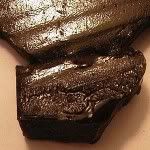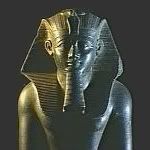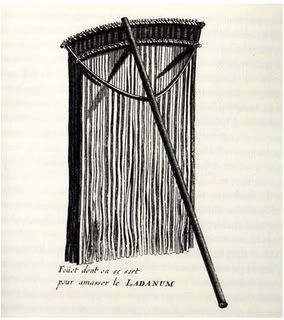In this month of chypres examination and discussion, Perfume Shrine pondered on their
origin, their
composition, the
modern variations, their
aesthetics and the
relation they have to the zeitgeist (Click on the links to go to respective subject). It was about time we focused on
the question whether there are indeed masculine fragrances that fall into this category of chypre.
The matter arises because most of the frequently mentioned chypre perfumes are feminine, if you think about it. We also attribute traditionally perceived feminine characteristics to them, such as elegance or sartorial sophistication (for some reason this wouldn't resonate with the Italian man, but I digress).
And the subcategories of floral or fruity within chypre often predispose one to think into such terms, although the seasoned perfumed lover is not restricted by such artificial limitations pertaining to gender.
Like we discussed before
Chypre relies on the juxtaposition of bergamot and oakmoss, with the traditional inclusion of labdanum and usually of patchouli or vetiver. There is
a comparable fragrance family for men, called Fougère (pronounced foozh-AIR), the French word for fern. In reality this is a fantasy accord because ferns have no real scent of their own. Fougère fragrances have fresh herbaceous notes, juxtaposing lavender with oakmoss on a fern-like base, with an element of Coumarin (the smell of freshly mown hay, naturally found in tonka bean, the seed of a West African tree which contains up to 40% of it).
Masculine fragrances have usually gone the route of the fougère when trying to recreate a forest floor impression instead of chypre, perhaps due to the fact that chypre perfumes have been marketed to women, or because they often included floral elements which are traditionally thought of as feminine in the 20th century (albeit not before!).
Classification is rather dubious territory, as there are countless exempla of diversifications according to the source. Open any guide or reference site and you will see the differences leaping to the eye. Therefore the following is only an attempt to examine whether there is any logical base in attributing scents to this or that odorous category.
For starters, the matter of
whether leathery scents are a subdivision of chypres (as they do mostly contain the basic accord)
or a seperate category termed Leather/Cuir (according to the French Society of Perfumers) is significant. Going by that leathery and oftentimes tobacco scents very often do smell rather more masculine; such as the various Cuir de Russie versions (Chanel, Creed, Piver etc),
Miss Balmain and
Jolie madame by Balmain, Caron's fierce
Yatagan and smoky
Tabac Blond , or
Bandit by Piguet, lost semi-legend
Jules by Dior and
Bel Ami by Hèrmes. You will notice that there is a proliferation of both -marketed as- masculine and feminine scents in the above. Should we or shouldn't we classify them under chypre? The matter remains open for discussion.
Another cross-polination happens, involving woody undertones.
An example that would implicate those as well as a whiff of leathery castoreum is
Antaeus by Chanel. Decidely butch, pheromonic almost and a powerhouse, it came out in 1981 by in-house perfumer Jacques Polge. It contains the pungency of male sweat and animalistic nuances with honeyed touches and much as I love it, I can't bring myself to don it on my person. The official notes listed (clary sage, lavender, myrrtle, labdanum, patchouli) do not include the classic accord of chypre despite the cool opening on an earthy animalistic background, yet one is hit with such a composition that might remind one of the family.
Shiseido's
Basala is another one, as well as the original Armani
Pour Homme.
There is some argument that coniferous elements such as pine essence as witnessed in
Pino Sylvestre could be included in a subdivision of chypre.
The flip side of this confusion would be the lighter citrusy notes that might blurr
the line between hesperidic and chypre. As chypre compositions contain a discernible citrusy pong via the inlusion of Calabrian bergamot, the notion isn't too far off.
Chanel Pour Monsieur could be such an example. Elegant, refined, conceived while Coco Chanel was still alive, it pays tribute to all the famous men she had known. Created in 1951 by Henri Robert, second nose in la maison Chanel after legendary Ernest Beaux, it plays on a sharp and clean citrusy top that includes lemon, petit grain (the essence rendered from the twigs and leaves of the Seville bitter orange tree,
Citrus aurantium) and neroli (the distilled essence of the flowers). It then segues to spicy notes of cardamon and white pepper that invite you closer, only to end on a whiff of cedar and vetiver that retains freshness and discretion for the wearer. Perhaps citrus-aromatic would be a closer categorisation.
And there are various decidedly masculine propositions that reek of
the pungency of patchouli and vetiver, notes that are so much used for
the modern chypres of the last few years.
Givenchy
Gentleman, which is sometimes described as a woody oriental, is a beast of a patchouli perfume that remains untamed even though its name would suggest hand kisses and opening doors for you. He does, but then ravages you, ripping your bra off.
The original
Aramis for Men could be another case in point, especially given -again!- the suave name that would belie its intentions that open on a crisp note of artemisia and bergamot. It has of course intense woodiness too, thanks to sandal, but with the elements of a classic chypre in place as well. Coupled with a pinstripe suit it goes out to the City to trade stocks and in the lunch break goes off for supposedly a gym session that is in reality an illicit tryst.
Why do such powerful and assertive masculine fragrances are given names that imply a more gentle approach? This could be the subject of another post...
For the time being,
please offer your suggestions on masculine chypres and the reason why you classify them thus.
Picsfrom parfumsdepub

.jpg)















.jpg)